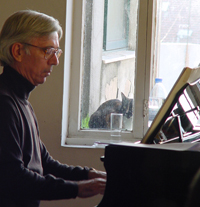|
On March 16 the Sá de Miranda Municipal Theatre in Viana do Castelo presented a monographic concert dedicated to Cândido Lima – a form of a preview (pre-listening) of a double CD entitled “Para além das árvores” (“Beyond the Trees”). In mid-April the Portuguese label Numérica will release this album, entirely composed of the composer’s music.
One must make reference to this excellent initiative of the municipality to promote such manifestation, proving to be indifferent to some common “urban myths”, concerning the public’s taste and the artistic pertinence of the so called avant-garde music. Giving value to a prominent figure from the 1960s generation is, apart from the media commemorations, an act of promotion of living art and true patrimony.
The Grupo Música Nova (New Music Group), formation of variable geometry founded by Cândido Lima in 1975, was in charge of the performance. The following musicians participated in the referred concert: Jed Baharal (violoncello), Olavo Tengner Barros (flute), Jorge Salgado Correia (flute, alto flute), Carlos Ferreira (clarinet), Domingos Freitas (oboe), Suzanna Lidegran (violin, viola), Cândido Lima (piano, conductor and sound projection), Ângela Lopes (sound projection), Margarida Magalhães (voice), Florian Petzborn (double bass), Vítor Pinho (piano), Cláudia Pereira Pinto (voice), Hugo Queirós (clarinet, bass clarinet) and Pedro Couto Soares (recorder). This welcome plethora of excellent musicians gave us a varied portrait, and well organized in its unveiling, of a work fundamental for Portuguese culture. Cândido Lima’s production, just as the one of his contemporaries, would deserve to be present regularly in concert programmes and to be studied with attention, not only in praxis and musical education but also theoretically, within musicological analysis. What is the best in Portuguese art music is set apart from cultural life, not only because of an absurd prejudice in relation to more sophisticated art forms, but also through the persistence of “aesthetic” debates, which combine, in different proportions according to its actors, lack of culture and strategy of power. The following observations have only the pretension to give some hints in order to understand the rich musical personality of Cândido Lima.
The composer’s fascination with the continuum is apparent, getting closer to a kind of plastic music, acording to the terminology of Pierre Schaeffer. Excerpts from “Cenas de Villaiana” (2008-2012), for piano and electronics, were diffused as background music (música de estar in Portuguese, a term brilliantly and freely translated by Pedro Junqueria Maia from the expression musique d’ameublement, which I reclaim with proper reverence). The field recording side and some folkloric sonorities are integrated, with great naturalness and without simplifications, more or less ethnomusicological, in a harmony, which even if dense, is always luminous and euphonic.
Another aspect of Cândido Lima’s aesthetics is the melodic dimension – imaginative recreation of what could (not) be an archaic voice, in which the magnificent integration of microtonal details and expanded techniques give a new sense to the underlying polyphony of any good melody. “Canto Antigo” (2002), for clarinet and piano and “Cantorião” (1997), for double bass and piano, are beautiful examples, in which the keyboard is neither an accompaniment nor a mere sound background, but rather, a subtle setting. Indeed the daring idiom of the instrumental writing never degenerates in mere exhibitionism; a example is “Le Chanteur du Val” (2004) for recorder.
Obviously there are cases, in which different aspects (plastic continuity, fine contrast of harmonic fields, melodic generosity) are combined and inter-modulated. In “Optic Music” (2010), for live piano and three pre-recorded pianos, the “phasing” techniques dear to Steve Reich, obviously adapted to a personal language, are extended without the somewhat rough obligation of progressive evolution, dear to the American composer. “Tissages I” (1992) and “Tissages II” (1993), both for a larger ensemble, have a fascinating ambiguity between the harmonic web and individual voice. This ambiguity is reinforced by the superior orchestration / spatialization. Nevertheless, without any doubt, the concert’s culmination was the premiere performance of “NI(Y)NI(Y)ANNA” (2011-2012), for violin and electronics, a magnificent piece, in which the multiple tendencies of the composer’s art find themselves integrated in a discourse, in which the timbric, melodic, rhythmic and harmonic invention is merged in a whole, magical, essentially idiomatic, without common places, seductive yet without trivialities. It is a notable work, served by the excellent Suzanna Lidegran.
As always during a crisis, also in cultural terms we encounter a reductive nationalist discourse, when not opportunistic; Cândido Lima’s work is one of these, which without auto-proclaiming an ideological eagerness, has a lot more profundity, something, which dignifies being Portuguese – it is rooted in the affective resonances of the erudite and popular tradition, eminently personal and fundamentally open to the world.
To conclude I permit myself to observe that, paying homage to an artist fascinated with word plays, I entitled this text with an anagram of the concert’s title and of the CD; I dare to think, somewhat in Lima’s style.
|
